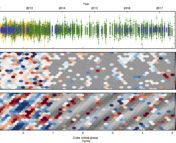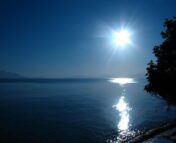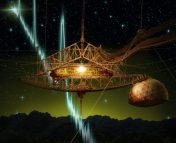Written by Bryanne McDonough and Haley Wahl
From the search for extraterrestrial intelligence to the discovery of the first exoplanets, the Arecibo Telescope had an incredible impact on astronomy. Completed in 1963, the telescope was decommissioned in November 2020 after multiple cables snapped, causing significant damage. In honor of this telescope’s many contributions to astronomy over the decades, today’s Astrobite will explore Arecibo’s legacy.
The Telescope and the Collapse (written by Bryanne)
Located in Arecibo, Puerto Rico, the telescope was used for radio astronomy, atmospheric science, and even the search for extraterrestrial intelligence (SETI). It has also been used as a movie set, perhaps most famously in the James Bond movie, GoldenEye. At 1,000 feet (305 m) in diameter, it was the world’s largest single-aperture telescope until 2016 when that title was taken by China’s Five-hundred-meter Aperture Spherical Telescope (FAST).
The dish was built into a natural sinkhole, providing some natural support for the tens of thousands of aluminum panels that made up the disk. Receivers and transmitters were suspended by cables above the dish, and could be moved to aim at targets. More information about the structure and the telescope can be found here.
A series of storms and hurricanes in the 2010s led to structural concerns. Hurricane Maria in 2017 caused some damage to the telescope, further raising concerns. The facility closed on August 10, 2020, after a support cable snapped and fell, ripping a gash into the disk. While waiting on a replacement cable, another support snapped on November 7. This effectively spelled the end of the telescope, as it was determined that the increased strain on the other cables could lead them to snap, making any repairs too dangerous. As a result, in November, the NSF announced that the telescope would be scheduled for decommission.
On the morning of December 1, another cable failed, and then another and another. The 900 metric ton platform that held the receiver and other instruments fell to the ground, causing substantial damage to the dish. No one was hurt in the collapse, which was captured by aerial and ground-base. The video can be distressing for some to watch, but it can be found here (collapse video credit: Carlos Perez, drone footage credit: Adrian Bague).
While the loss of this telescope is devastating to the astronomical and Puerto Rican communities, its legacy will live on in the science it enabled and the people it inspired. The following is but a small sampling of the many monumental scientific findings from the Arecibo Telescope.
Discovery of the First Exoplanets
In 1992, astronomers Aleksander Wolszczan and Dale Frail published a paper declaring the first discovery of extrasolar planets around a pulsar (a rapidly pulsating white dwarf or neutron star). Wolszczan detected the millisecond pulsar PSR B1257+12 in the Virgo constellation with Arecibo in 1990. Millisecond pulsars should be excellent clocks, but this pulsar was wobbling back and forth, causing the pulses to be slightly irregular. This wobbling was due to the presence of planets tugging on the pulsar while they orbited. Frail and Wolszczan originally announced the discovery of two planets, but a third was confirmed in 1994.
The fact that these planets were located around a pulsar was surprising. A pulsar is either a white dwarf or neutron star, both occurring after main-sequence stars die violent deaths. Before this discovery, it was thought that planets would not survive past the main-sequence stage of a star’s life. Most likely, these planets came from a second round of planetary formation in a debris disk surrounding the pulsar, although there are other possibilities, detailed in this surprisingly accessible 1993 paper.
Arecibo’s detection of the first extrasolar planets kicked off the study of exoplanets, and the Nobel-winning discovery of 51 Pegasi b followed shortly after in 1996. Now, there are over 4,000 confirmed exoplanets and counting.
The Search for Extraterrestrial Intelligence (SETI)
Arecibo was featured in Carl Sagan’s book Contact, as well as in the movie-adaptation for good reason. Humanity has been broadcasting radio signals for well over 100 years now, leaking radio waves out into space. Although those first signals have dissipated by now, we continue to send out a bunch of chatter. If there is nearby intelligent life listening, they might pick up on those signals and maybe even send something back. Or maybe they are leaking their own signals. Either way, extraterrestrial signals aren’t going to be picked up on a TV, they will require a large receiver like a radio telescope. Arecibo was used to listen for alien chatter on occasion, dependent on often-fraught funding for SETI programs.
Although we have yet to detect a signal sent by extraterrestrial beings, we have sent our own. Arecibo transmitted the first intentional message to extraterrestrials in 1974. How do you send a message to aliens who don’t speak our language, and know nothing about us? Although the message is unlikely to ever be received by anyone, it was an interesting exercise to start thinking about. The message is depicted in Figure 2.
The Mystery of Repeated Fast Radio Bursts
Arecibo was the first telescope to detect a repeated fast radio burst (FRB, affectionately pronounced as “furbie”) in 2012. FRBs are highly energetic signals whose origins are still a mystery. Before the Arecibo detection they were thought to be one-off events; however, Arecibo detected multiple FRBs from the same source. A single flash is not enough to pinpoint the distance, but with the repeated bursts, scientists were able to determine that the signal came from a dwarf galaxy, confirming that the signals mostly originate from outside the galaxy. The loss of Arecibo will certainly impede the further study of FRBs, whose cause is still unknown.
Radar Mapping
Arecibo was one of two planetary radar facilities in the world, besides receiving signals, the telescope is also able to transmit them (like the message mentioned above). This transmitting capability allowed astronomers to use radar techniques to study solar system objects within the orbit of Saturn (the round-trip light travel time beyond that was too long to detect the return signal).
Arecibo made more accurate measurements of the distance to and rotation periods of the other planets, and many more important observations. In 1990, Arecibo detected ice in shadowed craters on Mercury, which was later confirmed in 2012. The radar was able to pierce through the cloudy haze surrounding Venus to map the surface, discovering evidence of tectonic activity, including ridges and valleys as well as lava flows from past volcanoes.
The radar technique was also used to track asteroids by observing their speed and location, and sometimes determining their shape. The loss of Arecibo puts additional demands on the few other facilities that can do this tracking, compromising our ability to detect asteroids that may hit Earth before it’s too late.
Although Arecibo was well over 50 years old, new and exciting science is still being done with data from it every day.
The Telescope and Its Community (written by Haley)
Arecibo’s legacy extends far beyond just producing science; it also had an incredible impact on both scientists and the people of Puerto Rico. In a series of tweets, Edgard Rivera-Valentín, a scientist at the Lunar and Planetary Institute in Texas, said, “Think about what the Golden Gate Bridge means to San Francisco, Statue of Liberty to New Yorkers. Arecibo is this and more to Puerto Rico because it has gone beyond an icon.”
Scientists around the globe have been using the hashtag #WhatAreciboMeansToMe to express how the telescope has personally impacted them. Marialis Rosario Franco , a PhD candidate at the University of Texas Arlington and author at our sister site Astrobitos, expressed her devastation about losing Arecibo:
“The loss of The Arecibo Observatory means grieving the dream of returning to my land to work as a radio-astronomer whilst contributing to the development of a solid astrophysics program for the Caribbean youth,” she tweeted.
Dr. Nohely Miranda-Colón, a professor of physics at the Universidad de Puerto Rico Recinto de Mayaguez, told Astrobites how important the Arecibo Observatory is to the people of Puerto Rico, where it inspired generations:
“I think for every Puerto Rican child, as soon as they express even the most minimal interest in science, someone will mention the Arecibo Observatory to them. It’s hard to quantify how many Puerto Ricans have pursued careers in STEM because they were influenced by the presence of AO, but almost all my peers have told me that in one way or another this was the case. In a field where Latinxs are underrepresented, AO served as our ultimate ‘icon of science.’ It was an ever present reminder that ‘we’ (Latinos) could do it. That science could happen here, and it could be done by people who look like us and speak our language! I cannot say with 100% certainty that I would be a physicist today if AO wasn’t there. This also is where I met Maura McLaughlin and Joanna Rankin. I cannot overemphasize how much these two pioneering women changed my life. AO has been such a positive influence in my life that I will do whatever I can, no matter how small to help rebuild it.”
Junellie González Quiles, PhD student at John Hopkins University from Puerto Rico, shared her story on Twitter. The first time she realized she wanted to do astronomy was when she was in fifth grade, when astronomers from the Arecibo Observatory came to her summer camp and brought telescopes for the students to observe though. She was accepted into the Arecibo Observatory Space Academy in high school which gave her her first ever research experience in astronomy and space-related fields, and cites that program as a life-changing opportunity that brought her to where she is today. One of her tweets read:
“The Arecibo Observatory holds a special place in my heart. It always will. Such magnificence, beauty and significance to science it will always hold. It’s where scientist Junellie was born and I will always treasure that.
What Happens Next for Arecibo/How Can I Help?
There are multiple ongoing efforts to help preserve the legacy of the Arecibo Observatory and maintain its influence in Puerto Rico. A majority of these are being led by a group titled “Save the Observatory,” which you can follow on Twitter, Facebook, Instagram, and YouTube. If you were influenced by the observatory, please continue to share your stories with the hashtag #WhatAreciboMeansToMe. You can also use the hashtags #savetheAO, #rebuildAO.
There is currently a petition to rebuild the Arecibo Observatory in order to regain the unique capabilities the instrument held and inspire future generations on the island, which you can sign here. To donate to either the public outreach and education efforts (the Ramos Foundation Science & Visitor Center) or to research and equipment, visit Arecibo’s official website for donations. You can also contact your local representative to let them know how important the observatory is and to push for its rebuilding/funding.
The Arecibo Observatory has been a symbol of Puerto Rico, has influenced countless scientists across the island and across the world, and has made some of the most important scientific discoveries in the history of radio astronomy. Its influence will be felt for centuries to come, and the legacy of Arecibo will live on.
A follow-up article, written by Astrobitos authors, will focus more on the Puerto Rican community and the cultural and scientific loss Arecibo represents. An English translation will be published on Astrobites.
Disclaimer: Haley has used Arecibo many times for her research and as a part of the NANOGrav collaboration.
Astrobite edited by: Briley Lewis
Featured image credit: University of Central Florida




